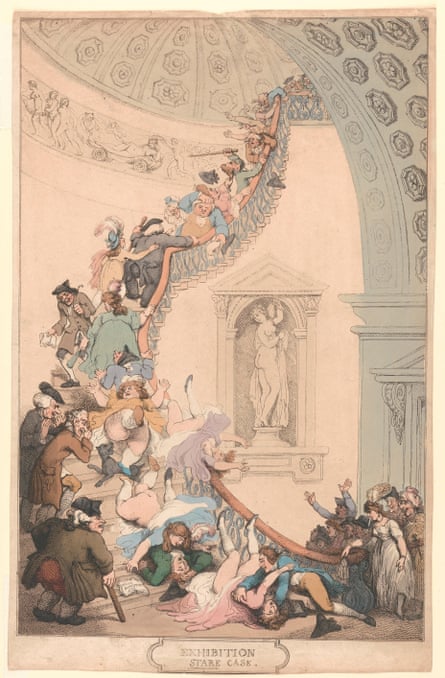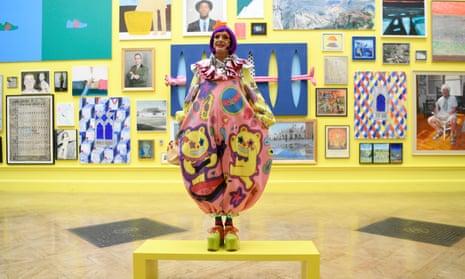There’s an orgy going on at the Royal Academy. People are tumbling over each other, cavorting in ecstasy, revealing all. Who knew the summer show could be so subversive?
This riotous assembly appears in a deliriously funny and rude satire on the Royal Academy’s annual exhibition drawn by Thomas Rowlandson in about 1800. It’s included in The Great Spectacle, a survey of the (nearly) 250-year history of what is now called the Summer Exhibition that runs parallel to this year’s show. What a quarter-millennium it has been. Rowlandson’s watercolour, called The Exhibition Stare Case, portrays fashionable society fighting its way up the spiral staircase in the Academy’s old home in Somerset House. In their excitement, they’ve lost their footing. The dirty-minded Rowlandson imagines the crush turning into a mass ogle and grope.
This annual show was where Gainsborough and Reynolds, Constable and Stubbs competed for attention. From its first instalment at the year-old RA in 1769, through the Romantic age, it was the Turner prize of its day – with Turner in it. He exhibited his last new works here in 1850, the year before his death.

The Great Spectacle puts a brave spin on what happened next, celebrating the Victorian salon it became – there’s a touching portrait by William Frith of Oscar Wilde at the 1881 private view – but the reality was depressing. By 1900, the Royal Academy was a profoundly conservative institution, and its Summer Exhibition a parade of establishment taste. In his painting Does the Subject Matter? the 1940s president of the Royal Academy, Alfred Munnings, viciously satirises modern art and its fans; the curators try to suggest he’s ambivalent, but this is the same man who boasted that he and Winston Churchill wanted to kick Picasso in the balls.
The Great Spectacle can’t hide the fact that the Royal Academy Exhibition stopped being a creative cultural force when Turner died in 1851.
Now along comes Grayson Perry.
In asking Perry to co-curate their summer show in their quarter-millennial year, the Royal Academy has let him turn it inside out and upside down. He’s saved this open submission gathering of the famous and not-so-famous from the mediocrity that usually stultifies it by instituting a bold and ruthless measure. Usually, there are a lot of so-so works of art, the hard efforts of well-meaning plodders whose competence and sweat get them selected – a huge honour.
This year, getting selected is not such an honour. For Perry has filled the summer show with crap. I mean actual garbage: talentless, throwaway rubbish, a lot of it apparently made by jokers after getting home from the pub.
There are pictures made with eggs, monkey portraits, childlike banners, a marble relief called Pig Man (actually, that’s by a “proper” artist), and, most bizarrely, a whole collection of portraits of Perry, submitted either by fans or by people who hoped it was a sure way to get selected. They were right. Elsewhere, someone has embroidered over a photo of the Queen from the front page of the Guardian, while another hopeful has acquired a Ukip poster from the EU referendum and replaced the word “Leave” with “Love”. Only the cluster of TV cameras around it alerted me that it’s by Banksy.
The biggest room in Burlington House is painted bright yellow and densely hung with weird and wonderful works. Olga Lomaka’s elongated fibreglass sculpture of the Pink Panther, strung sideways through an abstract blue canvas, is perhaps the most bonkers of all – and she’s a professional. Next to this hangs a deadly serious and adoring portrait of Nigel Farage by David Griffiths. Perry’s show is politically as well as aesthetically promiscuous. Here, Banksy shares space with Farage. It results in a fascinating psychological delve into darkest Britain in 2018. By including so much art the selectors would normally put straight in the reject pile, this show charts the subconscious of our times. Haunted by Grenfell – I counted two works of art about it – and divided by Brexit, this is nothing like the garden party nation the summer show traditionally suggests.

Some established artists fit into the madness amazingly well. Rose Wylie shows a huge painting based on an African shop sign. Her sloppy splendour stands out for its design and colour. In an “art world” context, she looks like an outsider: here you see how accomplished and clever she is.
Paula Rego, too, excels with a grotesque triptych of tortured bodies. David Hockney exhibits tremendous, vast photographic works that map his studio and expound his belief that western perspective limits how we see. Among all the amateurs he is amateur-in-chief, riding his hobby horse, glowing with intellectual enthusiasm.
There’s something odd happening in art, and Perry has caught the moment. Boundaries of age and style, cool and uncool no longer seem to have anything to do with art’s future. Perhaps its future lies in the past. Or vice versa. I don’t know where I am after this crazy show. This is the most liberating exhibition of new art I’ve seen for ages, because it obliterates definitions of what’s good or bad, archaic or modern, and invites us to sample all the ways people can use a thing called “art” to express feelings and ideas. The more the merrier, the madder the better.
The barbarians have stormed the gates. And if ever a palace needed ransacking by the mob, it was Burlington House. I don’t know what Constable and Turner would think. Rowlandson, however, would have a bloody good laugh.

Comments (…)
Sign in or create your Guardian account to join the discussion